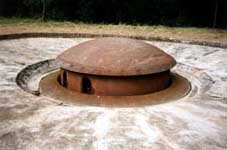
To order Hitler Sites ($55) click here
"The Maginot Line" during
the Sitzkrieg (phony war) March 1940:
Launch Real Player
This option requires Real Player.
Click here to download Real Player
Launch Windows Media Player
This option requires Microsoft's Windows Media Player.
Click here to download Windows Media Player
 This
series of fortifications on the French German border contributed significantly
to French complacency in the face of resurgent German military might after
Hitler's rise to power in 1933.
This
series of fortifications on the French German border contributed significantly
to French complacency in the face of resurgent German military might after
Hitler's rise to power in 1933.
Running from Longwy in northeast France to Basel, Switzerland, the Maginot Line
was named after French war minister André Maginot (1877-1932).
Because certain modern fortresses had held out against German artillery during
World War I, and saved military manpower too, Maginot urged the French
government to build a permanent fortified line to guard against German attack.
In 1929, during Maginot’s second term as minister of war, construction began on
the French northeast frontier. Maginot died in early 1932, but his project
continued and was completed in 1938.
The Maginot Line had concrete thicker than in any fortress ever built, and its
guns were heavier. It had air-conditioned areas for the troops, and was said to
be more comfortable than a modern city. There were recreation areas, living
quarters, supply storehouses, and underground rail lines connecting various
portions of the line. Strong-points could be defended by troops moved through
its tunnels by rail. The tunnels extended over 150 km, with 39 military units,
70 bunkers, 500 artillery and infantry groups, and 500 casemates (gun
fortification chambers), shelters, and observation towers.
But the Maginot Line had one glaring defect: It was, in fact, half a line. It
covered the French-German frontier, but not the French-Belgian. In 1940, the
Germans simply went around it. They invaded Belgium on May 10, crossed the Somme
River, and on May 12 struck at Sedan, the French city at the northern end of the
Maginot Line. German tanks and planes broke through the supposedly impassable
Ardennes terrain, and continued to the rear of the Maginot Line, making it
useless.
On May 16, Winston Churchill flew to Paris to meet with French leaders.
Churchill demanded to know the whereabouts of the strategic reserve of French
troops, the masse de manoeuvre, to repel the German invasion. General Maurice
Gamelin, “the world’s foremost professional soldier,” replied “aucune” (There
isn’t any).
The Wehrmacht did not capture many parts of the Maginot Line until after the
French capitulated. One of the last strongholds to fall was the fortress of
Marckolsheim, adjacent to the Rhine near Strasbourg. The thirty defenders fought
from June 15 to June 17, 1940. Hitler came to inspect this fort after the
surrender. Today the Marckolsheim fortress houses a military museum. Its
casemates, guns, and armor have been carefully preserved.
![]()
Hitler inspects the shattered Maginot Line, July 1940.
Launch Real Player
Launch Windows Media Player

